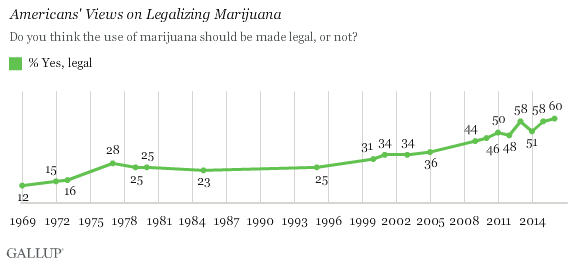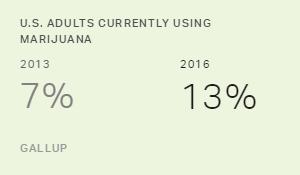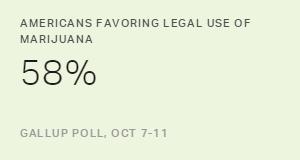Story Highlights
- Highest percentage of support recorded in 47-year trend
- Favoring legalization is up among all age groups in the past decade
- Large majorities of Democrats, independents favor legalization
WASHINGTON, D.C. -- With voters in several states deciding this fall whether to legalize the use of marijuana, public support for making it legal has reached 60% -- its highest level in Gallup's 47-year trend.

Marijuana use is currently legal in four states and the District of Columbia, and legalization measures are on the ballot in five more -- California, Arizona, Massachusetts, Maine and Nevada -- this November. As a result, the percentage of Americans living in states where pot use is legal could rise from the current 5% to as much as 25% if all of these ballot measures pass.
When Gallup first asked this question in 1969, 12% of Americans supported the legalization of marijuana use. In the late 1970s, support rose to 28% but began to retreat in the 1980s during the era of the "Just Say No" to drugs campaign. Support stayed in the 25% range through 1995, but increased to 31% in 2000 and has continued climbing since then.
In 2013, support for legalization reached a majority for the first time after Washington and Colorado became the first states to legalize the recreational use of marijuana. Since then, a majority of Americans have continued to say they think the use of marijuana should be made legal.
Today's 60% is statistically similar to the previous high of 58% reached in 2013 and 2015, so it is unclear whether support has stabilized or is continuing to inch higher.
Support Up From a Decade Ago Among All Age Groups
Support for legalizing marijuana use has increased among most subgroups in the past decade, but more so among certain groups than others. For example, support is up 33 percentage points to 77% among adults aged 18 to 34, while it is up 16 points among adults aged 55 and older to 45%.
| 2003 and 2005 | 2016 | ||||||||||||||||||||||||||||||||||||||||||||||||||||||||||||||||||||||||||||||||||||||||||||||||||
|---|---|---|---|---|---|---|---|---|---|---|---|---|---|---|---|---|---|---|---|---|---|---|---|---|---|---|---|---|---|---|---|---|---|---|---|---|---|---|---|---|---|---|---|---|---|---|---|---|---|---|---|---|---|---|---|---|---|---|---|---|---|---|---|---|---|---|---|---|---|---|---|---|---|---|---|---|---|---|---|---|---|---|---|---|---|---|---|---|---|---|---|---|---|---|---|---|---|---|---|
| % | % | ||||||||||||||||||||||||||||||||||||||||||||||||||||||||||||||||||||||||||||||||||||||||||||||||||
| National adults | 35 | 60 | |||||||||||||||||||||||||||||||||||||||||||||||||||||||||||||||||||||||||||||||||||||||||||||||||
| 18-34 | 44 | 77 | |||||||||||||||||||||||||||||||||||||||||||||||||||||||||||||||||||||||||||||||||||||||||||||||||
| 35-54 | 35 | 61 | |||||||||||||||||||||||||||||||||||||||||||||||||||||||||||||||||||||||||||||||||||||||||||||||||
| 55+ | 29 | 45 | |||||||||||||||||||||||||||||||||||||||||||||||||||||||||||||||||||||||||||||||||||||||||||||||||
| Note: Analysis combines data from 2003 and 2005 because each survey asked the question of a half-sample of respondents | |||||||||||||||||||||||||||||||||||||||||||||||||||||||||||||||||||||||||||||||||||||||||||||||||||
| Gallup | |||||||||||||||||||||||||||||||||||||||||||||||||||||||||||||||||||||||||||||||||||||||||||||||||||
Democrats and Independents Soar to Majorities Favoring Legalization
Additionally, support is up more among independents and Democrats than it is among Republicans, partly because of the older age skew of the last group. Seventy percent of independents and 67% of Democrats support legal pot use, a major increase since the combined survey of 2003 and 2005 when 46% of independents and 38% of Democrats supported the idea. While less than a majority of members in any political party backed legalizing marijuana in 2003 and 2005, Democrats and independents have fueled the recent nationwide surge in support.
| 2003 and 2005 | 2016 | ||||||||||||||||||||||||||||||||||||||||||||||||||||||||||||||||||||||||||||||||||||||||||||||||||
|---|---|---|---|---|---|---|---|---|---|---|---|---|---|---|---|---|---|---|---|---|---|---|---|---|---|---|---|---|---|---|---|---|---|---|---|---|---|---|---|---|---|---|---|---|---|---|---|---|---|---|---|---|---|---|---|---|---|---|---|---|---|---|---|---|---|---|---|---|---|---|---|---|---|---|---|---|---|---|---|---|---|---|---|---|---|---|---|---|---|---|---|---|---|---|---|---|---|---|---|
| % | % | ||||||||||||||||||||||||||||||||||||||||||||||||||||||||||||||||||||||||||||||||||||||||||||||||||
| National adults | 35 | 60 | |||||||||||||||||||||||||||||||||||||||||||||||||||||||||||||||||||||||||||||||||||||||||||||||||
| Republicans | 20 | 42 | |||||||||||||||||||||||||||||||||||||||||||||||||||||||||||||||||||||||||||||||||||||||||||||||||
| Independents | 46 | 70 | |||||||||||||||||||||||||||||||||||||||||||||||||||||||||||||||||||||||||||||||||||||||||||||||||
| Democrats | 38 | 67 | |||||||||||||||||||||||||||||||||||||||||||||||||||||||||||||||||||||||||||||||||||||||||||||||||
| Note: Analysis combines data from 2003 and 2005 because each survey asked the question of a half-sample of respondents | |||||||||||||||||||||||||||||||||||||||||||||||||||||||||||||||||||||||||||||||||||||||||||||||||||
| Gallup | |||||||||||||||||||||||||||||||||||||||||||||||||||||||||||||||||||||||||||||||||||||||||||||||||||
Republicans' support has doubled from more than a decade ago, yet only 42% of GOP members now support legal marijuana use.
Bottom Line
If recreational marijuana use becomes legal in California this year, many other states will likely follow, because the "Golden State" often sets political trends for the rest of the U.S. As more states legalize marijuana, the question of whether the drug should be legal may become when it will be legal. The transformation in public attitudes about marijuana over the past half-century has mirrored the liberalization of public attitudes about gay rights and the same-sex-marriage movement, the latter of which the U.S. Supreme Court deemed legal last year. It is possible that it might take a Supreme Court case to settle this matter, too.
Historical data are available in Gallup Analytics.
Survey Methods
Results for this Gallup poll are based on telephone interviews conducted Oct. 5-9, 2016, with a random sample of 1,017 adults, aged 18 and older, living in all 50 U.S. states and the District of Columbia. For results based on the total sample of national adults, the margin of sampling error is ±4 percentage points at the 95% confidence level. All reported margins of sampling error include computed design effects for weighting.
Each sample of national adults includes a minimum quota of 60% cellphone respondents and 40% landline respondents, with additional minimum quotas by time zone within region. Landline and cellular telephone numbers are selected using random-digit-dial methods.
View survey methodology, complete question responses and trends.
Learn more about how the Gallup Poll Social Series works.


